The global Covid-19 pandemic exposed numerous companies to a type of risk that is usually not considered a priority risk and that is Supply Chain risk. This is the risk that your suppliers or buyers of your products will not be able to meet their obligations to you due to factors that are beyond their sphere of control. Such a risk can be devastating to an organization due to its direct impact to the overall business operations. In the event that your supplier fails to supply you with raw materials on schedule; you cannot produce on time for your customers leading to loss of revenue and reputation on your end. Most recently KFC food chain in Kenya run out of one of their prime offerings and this was attributed to a delay in shipping lines due to the pandemic. Competitors of the fast food chain jumped on this breakdown in the supply chain to position themselves as a better alternative to the competitor as they were well stocked.
For risk managers, keeping an eye on the globalized supply chain can be a difficult task as it involves dealing with companies that may be miles away across different continents. The hard work of closely monitoring global supply chains and taking corrective action beforehand is very crucial; since failure in the supply chain could mean the death of the company or irrecoverable loss of reputation. One large scale retailer that was expanding in the Northern America region was unable to keep their doors open for more than 2 years after experiencing supply chain issues. Their inventory management system had issues and they ended up with over stocked warehouses but no stock in the shelves.
Conduct Due Diligence on Suppliers
Managing supply risk begins at the point of prequalification of suppliers. Risk managers together with procurement departments have to be willing and ready to collect all information regarding their suppliers. This information helps risk managers in assessing the different kinds of risks that the supplier may be exposed to that could hinder them from meeting their obligations. A credible supplier for example, is one who would have the financial muscle to meet your orders without requiring you to make any advance payments. Procurement departments can have a policy that requires prospective suppliers to submit financial information such as audited statements or recent management accounts. Of interest to the risk managers is the liquidity ratio and cash conversion cycle of the supplier. Risk managers want to see that the supplier can meet all their short-term liabilities comfortably. On the other hand, they also want to see that the time it takes for the supplier to sell their products and receive payment is short.
Risk managers should also scrutinize clients that the supplier is already working with. They want to avoid suppliers facing a possibility for customer concentration risk; whereby a significant share of the company’s sales are generated from one or few clients. A pharmaceutical company in North America had to change its capital structure after it was not able to renew 2 major distribution agreements that constituted more than 30% of their revenues. Client concentration risk could cause short term sustainability issues to the supplier and this may limit their ability to honour supply contracts to other smaller clients. Risk managers should therefore keep a keen eye on business news and dig deeper to understand if any of their supply chain actors is compromised when news regarding termination of contracts by large corporations is received.
Procure Global, But Consider Local Too
Supply chain managers should adopt a dynamic approach and avoid over-reliance on any particular actor in the supply chain. Globalization has enabled companies to source for goods and services from suppliers across the world, while keeping the landing cost low. However, this has led to over-reliance on the international cheaper suppliers; with procurement departments not actively looking for alternatives locally. The risk that this has on business operations was evident during the Covid-19 pandemic in 2020; when most companies that procure their supplies from China were not able to receive them in good time. To avert this kind of eventuality, risk managers together with procurement departments should ensure that they have alternatives both locally and internationally for critical supplies needed in their operations.
Lastly, just like all other risks, in order to manage supply chain risk effectively, the risk department will require support from the board and upper management level. Monitoring, preventing and mitigating supply chain risk will require additional resources; without a direct link to revenues; hence the need for management support in setting up the human capital and procedures required to manage it.
Author: David Kageenu


